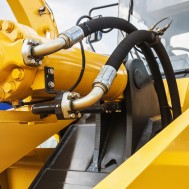Dynamic seals are like any other sealing device—they create a sealed barrier to keep out liquids, gasses and contaminants, as well as contain pressure. However, what sets dynamic seals apart from static seals is that they are applied where there is movement between hardware components and sealing surfaces. This motion can be broken down into three types: reciprocating, rotating and oscillating.
For each type of movement, there is a specific dynamic seal designed to withstand it.
Reciprocating
Reciprocating seals are applied in situations involving a moving piston and a rod. These are the most predominant seals under the dynamic umbrella. There are a number of factors to keep in mind when striving for optimum performance of reciprocating seals. These include:
- Failure to rebound at low temperatures may occur when thermal cycling from high to low temperatures if the wrong rubber compound is applied. Reciprocating seals are prone to this failure in low pressure applications
- To prevent extrusion, pressure shocks should be anticipated and effectively dealt with in both seal selection and system design
- Squeeze should be maintained at the proper levels. Low squeeze will reduce friction, but may lead to leakage in low pressure applications. Conversely, high squeeze will increase friction and sealing capability, but will lead to faster wear and an increased risk of spiral failure
- Stretch should not exceed 5% in most applications
Rotating
Rotary seals are used in rotating shafts. In these sealing applications, the turning shaft protrudes through the inside diameter of the o-ring. When designing a rotary seal, the most important factors to keep in mind include:
- Temperatures should not dip below -40°F or climb higher than 250°F
- Seal compounds should feature maximum heat resistance and minimum friction generating properties
- Compounds should be internally lubricated
- Shaft seals should be designed with no stretch over the shaft
- Squeeze should be kept to as little as 0.002″
Oscillating
In oscillating applications, the shaft moves in an arc within the gland and maintains contact with the inside diameter of the seal. When applying oscillating seals, the important factors to consider include:
- There is a tendency for the shaft to twist. To avoid complications, self-lubricating compounds should be applied
- Hardness should fall between 80 and 90 durometer
- Graphite-containing compounds should be used with caution as they tend to pit stainless steel alloys
Want to talk more about dynamic seals?
Contact an engineer today.
